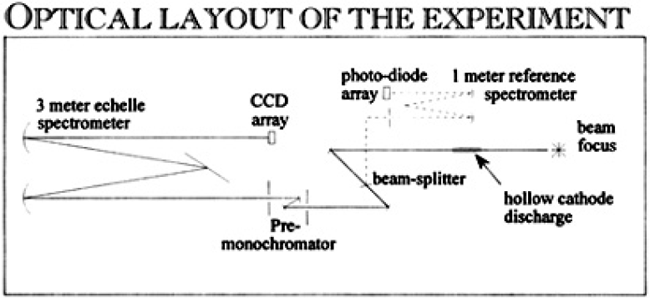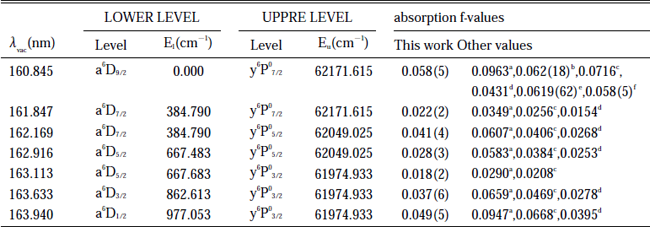光技術情報誌「ライトエッジ」No.8(1996年9月発行)
Ultra-Sensitive Absorption Spectroscopy on
lons using UV/VUV Synchrotron Radiation
K.L. Mullman, M. Sakai, and J. E. Lawler
University of Wisconsin-Madison
Madison, WI 53706
ABSTRACT:
An absorption experiment utilizing continuum radiation from the Aladdin storage ring, a 3m focal length vacuum echelle spectrometer, and a CCD detector array is reported. The extremely high spectral radiance of the storage ring in the UV and VUV provides unique capabilities for both basic atomic spectroscopy and for plasma diagnostic work. The thinned, backilluminated, boron doped (UV sencitive) CCD array extends the usual signal to noise advantage of a detector array in an absorption experiment to short wavelengths. This experiment achieves both spectroscopic resolving powers of 350,000 and sensitivities to fractional absorptions much smaller than 1% at deep UV and VUV wavelengths. Absorption spectra relative absorption oscillator strengths for Fe+ in a high current hollow cathode are presented. This experiment is applicable to many atomic ions in a variety of discharge plasmas.

There are three main components of the experiment
- ・The Continuum Source
- ・The Absorbing Sample
- ・The Spectrometer/Detector System
THE CONTINUUM SOURCE...
The continuum source is the white light beamline on the Aladdin storage ring at the Synchrotron Radiation Center.
TYPICAL OPERATING CONDITONS

The synchrotron Provides a bright photon beam ideal for our atomic absorption experiment in the 4-11 eV (300-110nm) range.
THE ABSORBING SAMPLE...
The absorbing source is a hollow cathode discharge
- ● 1cm inner diameter
- ● 10 cm long
- ● double sided
- ● water cooled
We use discharge currents from 0.02 A to 3.00 A, corresponding roughly to ion densities of 1010 to 1013cm-2.
The hollow cathode discharge is an ideal low-pressure gas-phase source for essentially every element in the periodic table, both neutral and singly ionized species.
THE SPECTROMETER SYSTEM...
Since we are measuring relative oscillator strengths, it is ideal to have two spectrometer/detector systems. This allows simultaneous measurements of the“reference”and the“unknown”,eliminating the need for long-term stability in the hollow cathode discharge.
One of our spectrometers is a high resolution instrument, the other is an intermediate resolution instrument.

THE DETECTOR ARRAYS...
We have given new life to the spectrometers by equipping them with state of the art multichannel detector arrays.
The CCD Array
The high resolution spectrometer has CCD array. It is an un-coated,borondeped, thinned, back-illuminated, deep UV sensitive device(SITe chip, Princeton Instruments hardware).CCD’s offer tremendous sensitivity with low read noise.
The Photo-diode Array(PDA)
The intermediate resolution spectrometer has PDA (EG&G chip,Princeton Instruments hardware). The PDA has a much larger photoelectron well than the CCD array. However the higher read noise requires either higher light levels or longer integration times.
THE MULTI-CHANNEL ADVANTAGE...
This multichannel absorption experiment is superior to single channel sequentially scanned absorption experiments. In a single channel experiment, any fluctuations or flicker in the continuum source are mapped into the noise, directly limiting the sensitivity of the measurements. In a multichannel experiment such as ours, all spectral elements are measured simultaneously, making intensity fluctuations or flicker inconsequential. The sensitivity of the measurements is now limited by Poisson Statistics, which accumulate quickly in a multi-channel experiment.
THE ANALYSIS...
The“Equivalent Width”is the integrated area of normalized absorption feature.

For the normalized lineshape, g(ν-ν0), we assume a full Voigt profile. The Lorentzian contribution is assumed to be primarily due to radiative (natural) broadening. The temperature of the atoms in the discharge is found by finding the best overall consistency in absorption measurements for several wellknown UV line pairs at each current used in the hollow cathode discharge.
DIFFUSIVE COOLING...
We see evidence of a non-Maxwellian velocity distribution in our discharge. A model of our discharge suggests that this is due to competition between the ambipolar diffusion (ion loss) rate and the collisional thermalization that fill out the high energy tail of the Maxwellian profile. With our discharge parameters and operating conditions, the diffusive loss rate and the collisional thermalization rates are nearly the same. Thus the more energetic ions diffuse out of the negative glow to the cathode of the discharge and are lost at a higher rate than low energy ions. Collisional thermalization is unable to completely“fill out”the high energy tail of the Maxwellian distribution. This is referred to as“diffusive cooling”and results in a truncated Voigt profile.
DISCHARGE TEMPERATURE...
To determine the effective ion temperature of our discharge, we measure several strong, well-known UV line pairs at a given discharge current and find the temperature which gives the best overall consistency for all of the rations. Since we continue to assume a full. Voigt profile in our curve of growth analysis despite the diffusive cooling in our discharge, the result of our temperature determination is artificially low or unphysical (below 293K, the temperature of the hollow cathode discharge cooling water) for discharge operating currents below 300mA. We recognize that this effective ion temperature is not the true heavy particle temperature of the discharge, but we use it in analyzing Fe+ absorption data with the discharge operating under a well defined set of conditions.
Well-known f-value ratios in Fe II and our measurements at each hollow cathode discharge current used in the experiment. The last row gives the effective ion temperature used for the Voigt profile in the curve of growth analysis.

aOscillator strengths from emission branching fraction and laser induced fluorescence lifetime measurements
(Bergeson, S.D., Mullman, K. L., Wickliffe, M.E., Lawler, J.E., Litzen, U., Johansson, S., 1996, ApJ 464)

Absolute VUV absorption oscillator strengths compared to values in the literature

a Nussbaumer, H., Pittini, M., Storey, P.J., 1981, A&A 102, 351
b Shull, J. M., Van Steenberg, M., Seab, C. G., 1983, ApJ 271, 408
c Kurucz, R. L., 1988, Trans. IAU 20B, 168
d Fawcett, B. C., 1988, Atomic Data and Nuc. Data and Nuc. Data Tables 40, 1
e Cardelli, J. A., Savage, B. D., 1995, ApJ 452,275
f Bergeson, S. D., Mullman, K. L., Lawler, J. E., 1996, ApJ, 464,000
はるか彼方の宇宙を探索するには、光を用いるのが昔からの、そしてこれからもおそらく主流の方法である。光はさまざまな情報を運んできてくれる。例えば、ある星、あるいは星間物質にどのような元素がどのような割合で含まれているかを教えてくれる。その定量的測定のためには量子力学でいうところの振動子強度が用いられる。各元素の振動子強度が求められており、これにより組成比が定量的に求まるのである。
しかし、実際に元素組成比を求めようとする場合、大量に含まれている元素はともかく、微少になればなるほど誤差が増幅されてくる。太陽系の元素組成を代表としていると思われる隕石(C1コンドライト)と太陽光から求めた元素組成比を比較したところ、軽金属ではよい一致を見るもののFe、Mn,Ge,Pb,W等では大きな乖離がみられた。(*1)
1990年に打ち上げられたハッブル宇宙望遠鏡(HST)は1993年スペースシャトルエンデバー号の画期的な修理によって本格稼動するに至った。宇宙に望遠鏡をおくことは1.大気の揺れの影響をなくし、2.紫外線(特に真空紫外線λ<200nm)の測定が可能になるという2点において地上の望遠鏡よりもはるかに有利に宇宙の観測ができる。このハッブル宇宙望遠鏡を使えば、真空紫外域のデータも利用してより精密な測定ができる。(*2,3)しかし、例えばFe+の振動子強度は近紫外域までしか測定されておらず、また、従来の方法では測定困難であった。
Wisconsin大学ではシンクロトロン放射光を利用してFe+の振動子強度を真空紫外域まで測定することに成功した。測定には3mのechelle回路格子(分解能~350,000)とCCDを組み合わせて使用し、ホロカソード放電をFe+源として吸収測定を行った。シンクロトロン放射光は可視からX線まで連続的に高輝度の光を含み、真空引きした回折格子分光器は真空紫外まで高分解を可能とする。CCDによる一括測定は例えば光電子増倍管などで逐次的に掃引するのに比べて掃引中の変化による誤差をなくし、測定時間も大幅に短縮される等、大きな利点を持っている。(*4)この方法によればFe+以外の原子・イオンでも真空紫外域まで測定可能となる。今回得られたデータにより、少なくとも数年来論争となっていたFeの成比に結論が出るだろう。
酒井基裕


